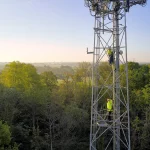The Top 2018 vs 2017 Fastest UK Mobile and Home Broadband ISPs
We’ve looked back at 2018 to see how the average download and upload speeds have changed across national fixed line broadband ISPs and mobile operators, although it’s no surprise to find that Virgin Media (fixed) and EE (mobile) are still front runners. But the picture changes when alternative “full fibre” ISPs are included.
Service speeds tend to rise for several reasons, with two of the biggest factors reflecting the impact of increased coverage by faster connectivity technologies and associated take-up by consumers. As such it’s useful to note that fixed line “superfast broadband” (24Mbps+) connections have slightly increased their coverage, going from 95% of UK premises at the end of 2017 to around 96% now.
Broadly speaking 2018 has also witnessed the first solid year of growth for a new generation of “ultrafast broadband” (100Mbps+) class technologies, particularly hybrid fibre G.fast and Gigabit capable “full fibre” (FTTP/H) networks. Prior to this year the ultrafast connectivity market was dominated by Virgin’s cable network but that is now starting to change, albeit slowly.
Advertisement
One issue is that so far the actual coverage of “ultrafast” services has only risen from around 53% at the end of 2017 to 56% now, which is partly because a lot of the new infrastructure tends to be focused on commercial urban areas and is thus overbuilding existing networks (e.g. Virgin vs Openreach vs Hyperoptic vs Cityfibre). At the same time Virgin has been slowly expanding their network too.
Nevertheless the roll-out of such services is still at an early stage, which means that for the time being the established market for slower hybrid fibre (FTTC) and copper based broadband products continues to dominate. As a result the improvements in average speeds seen below continues to be fairly gradual.
Meanwhile it’s a similar story where mobile operators are concerned, not least because 4G population coverage has been at a mature level since the end of 2017. Meanwhile on-going improvements in geographic coverage are welcome, but they won’t influence the overall performance results as much. But we may see future improvements due to better use of existing spectrum and 5G upgrades from 2019/20.
The Fastest Fixed Line Broadband ISPs
The following data stems from by Thinkbroadband‘s database (including our Broadband Speedtest) and we only include independent providers with strong national availability. We would like to fully cover smaller alternative network (altnet) ISPs but they tend not to produce much data and aren’t available to the vast majority of premises, although we do show a few examples of the fastest altnets below the main table.
Advertisement
Take note that the 4-5 slowest ISPs usually have a higher proportion of users on older copper ADSL lines and this suppresses their standing. So please take such results with a pinch of salt because the market is a lot more complicated than speedtest based data like this can show.
Average Download Speeds – Top 10
| No. | Operator | 2018 (Top 10%) | 2017 (Top 10%) | Change % |
| 1. | Virgin Media | 69.4Mbps (142.2Mbps) | 62.1Mbps (129.5Mbps) | 11.76% |
| 2. | AAISP | 55.1Mbps (74.3Mbps) | 38.2Mbps (72.8Mbps) | 44.24% |
| 3. | Zen Internet | 39.7Mbps (73.4Mbps) | 31.4Mbps (68.5Mbps) | 26.43% |
| 4. | iDNET | 36.5Mbps (70.8Mbps) | 31.9Mbps (68.2Mbps) | 14.42% |
| 5. | Vodafone | 31.5Mbps (58.6Mbps) | 25.1Mbps (43.9Mbps) | 25.5% |
| 6. | BT | 31.1Mbps (63Mbps) | 27.9Mbps (62.3Mbps) | 11.47% |
| 7. | Plusnet | 23.8Mbps (50.5Mbps) | 21.6Mbps (45.2Mbps) | 10.19% |
| 8. | EE | 22.6Mbps (46Mbps) | 16.9Mbps (36.2Mbps) | 33.73% |
| 9. | Sky Broadband | 20.3Mbps (37.1Mbps) | 16.1Mbps (35.1Mbps) | 26.09% |
| 10. | TalkTalk | 19.9Mbps (37.8Mbps) | 16.6Mbps (36.9Mbps) | 19.88% |
Average Upload Speeds – Top 10
| No. | Operator | 2018 | 2017 | Change % |
| 1. | AAISP | 17.8Mbps | 10Mbps | 78% |
| 2. | Zen Internet | 11Mbps | 8Mbps | 37.5% |
| 3. | iDNET | 8.4Mbps | 8.1Mbps | 3.7% |
| 4. | Virgin Media | 8Mbps | 7.4Mbps | 8.11% |
| 5. | Vodafone | 7.9Mbps | 6.6Mbps | 19.7% |
| 6. | BT | 7.2Mbps | 6.6Mbps | 9.09% |
| 7. | EE | 5.3Mbps | 3.7Mbps | 43.24% |
| 8. | Plusnet | 5.2Mbps | 3.9Mbps | 33.33% |
| 9. | Sky Broadband | 4.6Mbps | 3.5Mbps | 31.43% |
| 10. | TalkTalk | 4.5Mbps | 3.7Mbps | 21.62% |
Overall the average download speed of the top ten national providers was 34.99Mbps (up from 28.78Mbps at the end of 2017) and the average upload speed hit 7.99Mbps (up from 6.15Mbps). Not a lot has changed over the past 12 months, other than the broadly upward performance trend.
Advertisement
In terms of performance, Virgin Media is still the fastest widely available national operator for downloads, which is thanks to the strength of their cable (EuroDOCSIS) network that can currently deliver ultrafast broadband to over half of UK premises. But their network is weaker when it comes to uploads, which can easily be beaten by some of the cheaper FTTC (VDSL2) packages on Openreach’s network.
The biggest speed increase over the period was recorded by AAISP, although we’d take this with a pinch of salt because they’re also the smallest ISP in the table (i.e. smaller sample size) and so it doesn’t take much for their position to fluctuate.
Now flick over to page 2 to see how the fastest alternative network ISPs and mobile operators performed.
Mark is a professional technology writer, IT consultant and computer engineer from Dorset (England), he also founded ISPreview in 1999 and enjoys analysing the latest telecoms and broadband developments. Find me on X (Twitter), Mastodon, Facebook, BlueSky, Threads.net and Linkedin.
« Infracapital Grabs 50% Stake in SSE Enterprise Telecoms UK

















































Comments are closed